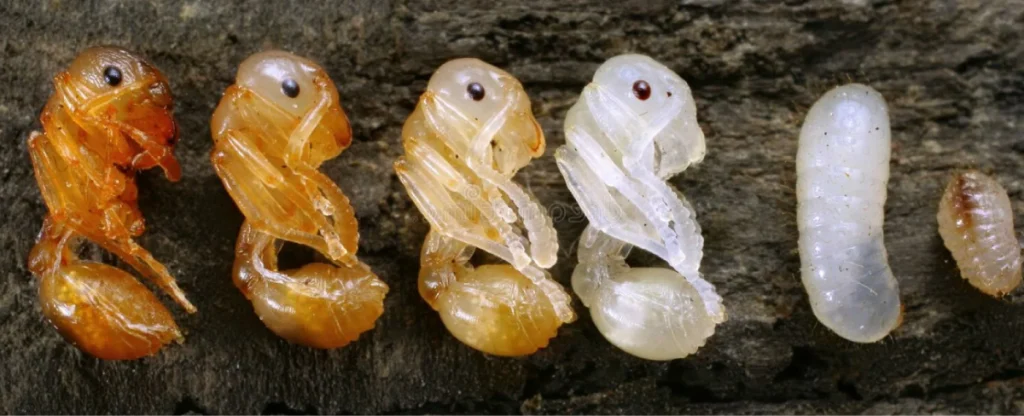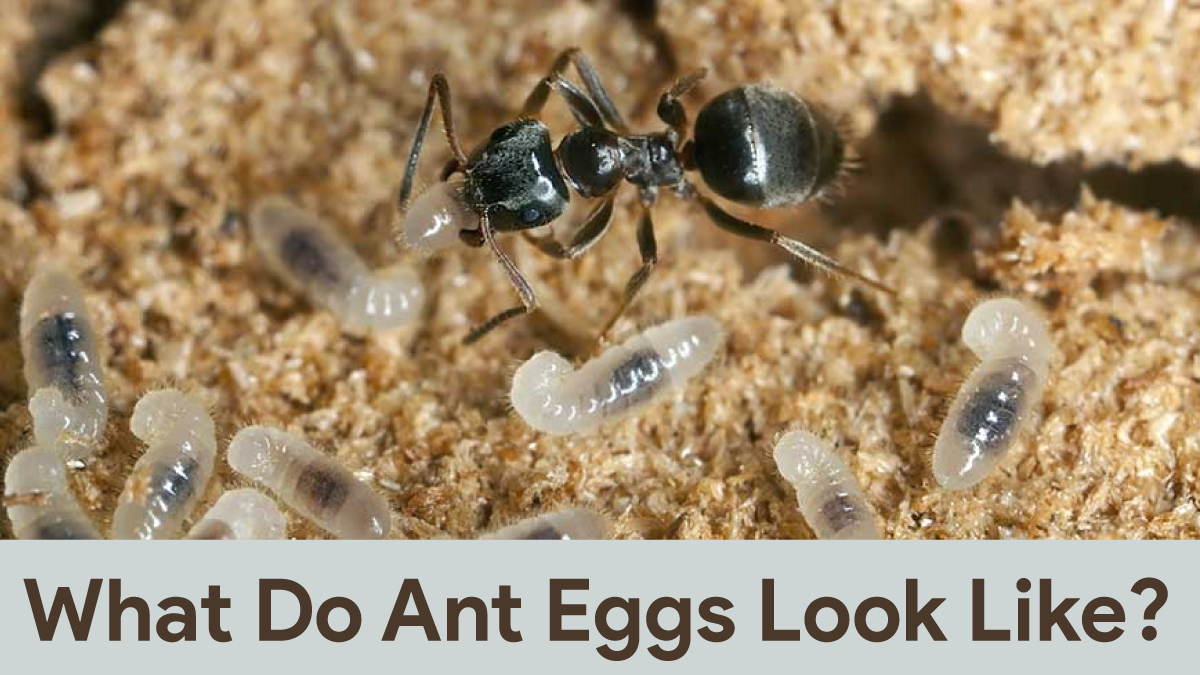Ants are one of those tiny creatures that you encounter in your house very often. You will see them climbing your bedside table or wiggling under your sofa in a line. These ant colonies tend to multiply when it comes to their population, making us wonder and compelling us to explore their reproduction cycle.
Has it ever crossed your mind, while you see an ant, what do ant eggs look like? If you knew what they looked like, you would reconsider, and instead of hunting for ants, you would hunt for their eggs to eradicate the source of origin.
In this article, we will examine the lifecycle of an ant and what ant eggs look like while delving deeper into other factors of the reproductivity span.
What Do Ant Eggs Look Like
The most important question we will begin with is to find out what ant eggs look like. Are they similar to eggs laid by those other insects that share a similar size with ants, or are they any different?
The genesis of the ant’s life begins with the growth of an ant’s egg. Subsequently, other stages follow this initial step, and then the ant proceeds to grow out of the egg after it has hatched and moves with the rest of the metamorphosis procedure.
An ant is the result of the mating between the queen (female) and the male ant. Later, the queen ant, the mother of the ant colony, undertakes the responsibility of looking after her children ants and ensuring they are continuously fed and housed in safe spaces.
An egg laid by an ant, as expected, is tiny in size. Obviously, you cannot expect an ant to lay an egg that outdoes its size; hence, the small size of the ant’s egg is self-explanatory. To provide an example of the size of an ant’s egg, then, it is to say that it can be no larger than the punctuation marks you will be seeing in this article.
Apart from being small, the laid egg by an ant is white in color and oval. If you ever see such tiny eggs around your house and have also seen ants, then undoubtedly, the eggs belong to the ant.
To eradicate the situation, you would have to act fast without wasting even a second because we are not kidding when we tell you that they multiply by the minute. You will be surprised to discover the number of eggs they lay a day later in this article.

Where Do Ants Lay Their Eggs?
When searching where do ants lay their eggs, there is no particular location that we can pin on, and the most generalized answer we can provide you with is- everywhere! Ants lay their eggs everywhere; however, the choices that ants make as to where they should lay their eggs differ according to the species the creature belongs to.
Although ant species vary with the locations they choose to lay their eggs, you can expect to find tiny, oval, white-colored eggs anywhere.
Whether you are considering looking for them in the garden, in the backyard, terrace, under the bed, or on your sofa, you can be prepared beforehand to find them in any of the spaces.
Nevertheless, this is not an implication for there are no specific favorite locations for the ants to lay their eggs. Some of the typical places where you can find ant eggs are places that are sheltered either by greenery or stones.
Therefore, any site that provides the ants with protection, water, and a reliable food source in adequate amounts will be the area the ant would settle to lay their eggs. These circumstances narrow down the potential laying grounds into three categories in the soil indoors or outdoors.
Commonly you can expect to find eggs in the grass, under the earth, under huge stones, in rotting wood, within cracked walls, in a litter of leaves, or even in other ant’s nests.
One commonality in all these locations is that they all are the least suspicious to humans, which means it provides the ant eggs with maximum security against any threat of being discovered.
How Long Does It Take for Ant Eggs to Hatch?
A requirement to examine what do ant eggs look like or how long does it take for ant eggs to hatch is to be well affiliated with their reproductive cycle. Focusing only on one part of their cycle will provide you with the answers you were looking for regarding the particular chosen stage.
However, you will still be blindsided about the rest and need help to make a cohesive and comprehensive sense of the ants and their life cycle. So, let’s walk you through ant metamorphosis, occurring in four primary stages.
Ant Egg
Lifecycle of an ant will begin when the fertile and expecting queen ant lays an egg into one of her chosen spaces. She will first dig deep into the ground, creating a steep hole similar to a cell, and then lay her eggs.
These laid eggs will be oval in shape, small in size, and white in color while being soft and sensitive in their texture. This is why the queen ant has chosen an enclosed space far from suspicion of another insect, human, or animal because, at this stage, the ants are susceptible to a lot of danger.
Also, because the eggs are soft and are yet to be hardened in their outer layering, any predator can make them their prey quite easily. It would be unchallenging for them to penetrate through the thin outer lining and swallow the inside of whatever the egg contains.
Additionally, out of all the eggs that the queen ant will be laying, not all are destined to grow into adult ants. Some may become prey, while the rest may not reach optimal potential due to a lack of resources.
Growth Into a Larvae
An ant will only progress to form into larvae after it has been hatched out of the egg. Therefore, the laid egg by the ant will hatch after and somewhere within the first three or four weeks after it has been secured into the ground.
The span is prolonged because it takes time for the outer lining of the ant’s egg to harden, and with a soft lining, hatching the ant out of the egg is impossible. At the larval stage, the hatched will start to depict signs of being a baby ant.
When an ant hatches out of the egg, it will be called larvae, shaped like a worm with no legs or eyes. This indicates that even at the stage of the reproduction cycle, these larvae have to be taken care of by the queen ant as due to lack of body parts still in growth, they cannot protect themselves against any risk of danger.
For larvae to proceed further into the cycle and grow, they demand a lot of nutrition. As a result, the queen ant and its worker ants will be foraging, attempting to hunt ample feed to feed the larvae.
Subsequently, by feeding the ants consistently, they will grow, and eventually, other body parts will emerge too.
The Pupa Stage
After five weeks have lapsed, three after the ant’s egg hatched and an additional two for which the larvae were consistently fed, it will appear longer, stronger, and more significant.
At this point, the baby ant is not a baby anymore and is transitioning towards achieving more growth; therefore, it is called a pupa. The pupa stage entails reorganization and rests for the ant before the practical world of continuously foraging unfolds itself on them.
You cannot still regard a pupa ant as an adult ant because differences stand. A pupa is distinguished from an adult ant because its antennae and legs are yet to emerge fully.
These body parts are present and can be seen, but they rest against the pupa’s body, folded. Another transformation you will examine at the pupa stage is the transition between their colors.
From a light white color, the pupa ants will evolve with their color into becoming darker and finally coming out with a darker shade of brown or black. Furthermore, according to the species that a pupa belongs to, they would either have a cocoon spun around for protection or would only rest naked and uncovered.
Adult Ant
At last, and after enduring all the transformative stages in the reproduction cycle, the ant will be coming out as an adult ant with all its bodily parts apparent. The ant will no longer be deprived of legs, wings, eyes, or antennas.
Adult ants will be of a dark shade when they appear; however, their initial color will also darken as they age. Now, the ants can leave their enclosed and confined spaces and explore the world surrounding them.
Again depending on the species, the time that the reproductive cycle will take is determined by the category they belong to.
How Many Eggs Do Ants Lay a Day?
Ants serve their purposes according to the three primary and prominent categories they are divided into a queen, workers, and male ants. The main job of the queen ant is to lay eggs and then look after her ant colony, ensuring that the colony is regulated and fed.
The worker ants are primarily female ants whose principal duty is foraging. They mostly spend all of their time outside of the nest in an attempt to look for food, and by the time the sun sets to take it back to their nests.
Worker ants are the most important among the three categories, and the burden of doing all the hard work falls onto them. Since the queen ant has to look converter the eggs she has laid, she does not leave their side and only waits for the worker ants to return to the nest carrying enough food to feed all the other ants.
Male ants do not serve any significant purpose nor play a vital role in the ant colony. Sometime after they have mated with the queen ant, they will die. This is how diminishing their position is that male ants are only required to be present for mating; after that, they don’t last.
Every ant colony is composed of ants in thousands. The number within the range of thousands can vary according to the species we are considering but what stands to be common ground between all is that they are enormous colonies.
Eggs Laid
Now that you are well aware that only the queen ant possesses the power and the ability to lay eggs let’s look into how many eggs ants lay a day. On average, the queen ant can lay eight hundred eggs in a day.
No wonder why the female ant is referred to as the queen ant. Also, see how we told you earlier that knowing the number of ant eggs laid in a day will answer all your concerns, especially why you keep seeing more ants around your house.
This is precisely why! A queen ant lays eight hundred eggs in a day on average. The figure estimates the eggs that must be laid, and they only drastically increase in number but never decrease.
Differing figures within the laid number of eggs is also, and once again, dependent on the type of species of the ant that you are taking into consideration. One thing to remember is that the number only always goes toward exponential growth but never towards shrinking.
Conclusion
We hope that all your concerns about what ant eggs look like have been addressed by this point. Also, our article has enlightened and educated you about the functioning of the ant colony, especially regarding its reproductive cycle.
